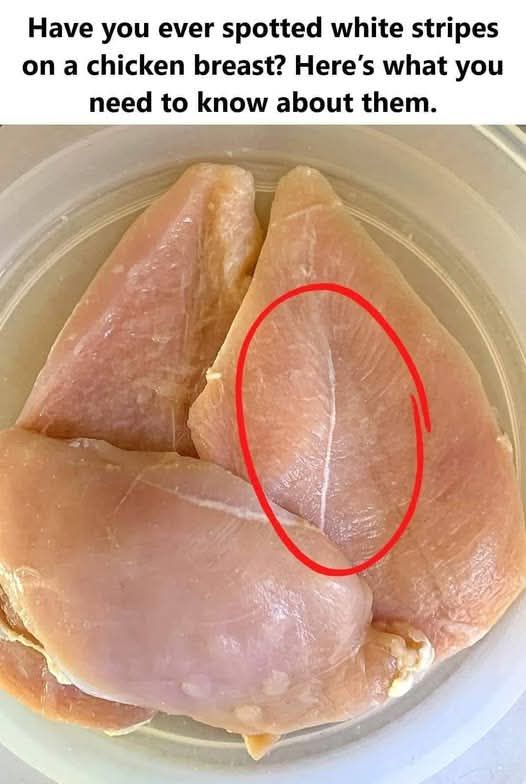ADVERTISEMENT
s, particularly those that are bred to grow rapidly and reach market weight quickly. The rapid growth puts stress on the bird’s muscles, leading to these fat deposits.
Why Do White Stripes Appear?
The main cause of the white streaks in chicken breast is linked to the way the birds are raised and the rapid growth rate they experience. Several factors contribute to the appearance of these white lines:
- Genetics and Breeding: Modern poultry farming often involves breeding chickens that grow larger and faster than their predecessors. These fast-growing birds, particularly those raised in commercial settings, have a higher likelihood of developing woody breast. This condition is most often seen in broiler chickens, which are bred specifically for meat production.
- Overfeeding and Growth Rate: Chickens that grow too quickly often develop stress on their muscles. As a result, the muscles become tougher, and fat and connective tissue deposits form within the muscle fibers. These deposits manifest as the white stripes you see on the chicken breast.
- Lack of Physical Activity: Broiler chickens raised in commercial farming environments are typically kept in confined spaces, limiting their ability to move and exercise. This lack of physical activity contributes to muscle stiffness and the development of fatty streaks.
- Age of the Chicken: Older chickens are more likely to develop this condition because their muscles have had more time to become stressed from rapid growth. However, this is most commonly found in younger, fast-growing birds that are raised for meat production.
Is It Safe to Eat Chicken with White Stripes?
Yes, chicken with white stripes is safe to eat. The white striations are made up of fat and connective tissue, both of which are not harmful to human health. However, they do affect the texture of the meat, which can make the chicken breast tougher and less juicy than a typical, smooth chicken breast without the striations.
While the presence of white stripes doesn’t make the chicken dangerous, it does impact the eating experience. The meat may be dry and more rubbery, which is why some people prefer to avoid it or cook it in ways that help tenderize it, such as slow cooking or marinating.
How to Cook Chicken with White Stripes
If you do find chicken breasts with white streaks, don’t worry—you can still cook them, but you may want to adjust your cooking methods to make the chicken as tender and flavorful as possible. Here are a few tips for cooking chicken breasts with white striations:
- Tenderize the Chicken: To help break down the tougher fibers in woody chicken breasts, you can tenderize the meat before cooking. Use a meat mallet to gently pound the chicken breast, which will help break up the connective tissue and make the chicken more tender.
- Marinate the Chicken: Marinating chicken can help improve its texture and flavor. Use a marinade with acidic ingredients (like lemon juice or vinegar) or enzymes (like pineapple or papaya) to help soften the meat. Let it marinate for at least 30 minutes to a few hours before cooking.
- Slow Cooking or Braising: Cooking the chicken slowly in a moist environment, like with braising or in a slow cooker, can help break down the muscle fibers and connective tissue, making the chicken more tender. This method also helps retain moisture, preventing the meat from becoming too dry.
- Cooking Methods: Consider cooking the chicken using methods that lock in moisture, such as baking with foil, grilling with indirect heat, or pan-searing with a lid. This helps prevent the chicken from drying out and improves its overall texture.
Can You Avoid Chicken with White Stripes?
While the white streaks in chicken breasts are common, there are a few steps you can take to minimize your chances of purchasing chicken with this condition:
- Buy from High-Quality Sources: Look for chicken that is labeled as “free-range” or “pasture-raised.” These chickens are often given more space to roam and more time to grow at a natural rate, which can reduce the likelihood of developing woody breast. They are also typically raised in less stressful environments.
- Choose Smaller Birds: Smaller chickens, often labeled as “young” or “small-breasted,” are less likely to have the white striations. These birds have more tender meat and are less likely to have the fast-growing issues that larger, commercial chickens face.
- Organic or Specialty Chicken Brands: Some specialty farms and organic chicken brands take extra steps to ensure their chickens are raised slowly and humanely, resulting in higher-quality meat that’s less likely to have the white striations. Look for certifications like “Certified Humane” or “Animal Welfare Approved” when shopping for chicken.
Final Thoughts
Seeing white stripes on your chicken breast may initially raise concerns, but rest assured that they are a normal occurrence and not a cause for alarm. These streaks are simply a result of the bird’s muscle tissue, fat, and connective tissue, and while they affect the texture of the chicken, they don’t affect its safety.
If you do come across chicken with these white streaks, try tenderizing or marinating it to improve the texture and ensure a more enjoyable meal. With the right cooking methods, you can still create a delicious, satisfying dish—even with a chicken breast that has those telltale white stripes.
So, next time you notice these streaks, just remember: It’s a common occurrence in commercial poultry production, and with the right approach, it doesn’t have to ruin your dinner!
